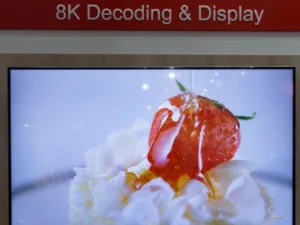ABox42 of Germany told use that it has a new STB in its M Series, the M35 which has support for UltraHD and is configured with Verimatrix Ultra Security. The company told us that although Android is getting a lot of support, Google is only interested in big operators at the moment and one of the ABox42 advantages is that it will work with smaller PayTV suppliers. The company continues to develop its smart home/IoT product range.
AMD was highlighting that its GPUs can be used with relatively ‘lightweight’ notebooks with external GPUs using ThunderBolt 3 and AMD’s ThreadRipper GPUs. A dual graphics board system was being used, but the system allows multiple chassis to be supported, as was suggested at the show, although the second box was empty. This kind of architecture can allow the GPUs to get on with rendering a ray-traced final image, while the PC is used for other functions. At IBC, Adobe said that it was trying to migrate more and more of the processing in its After Effects package to the GPU and that move would be aided by this kind of architecture.
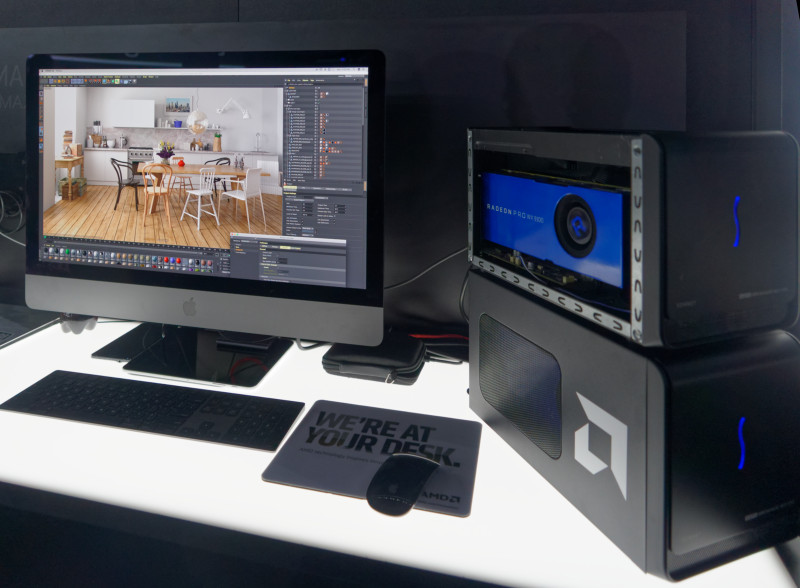 We hear more and more that Apple is very interested in external GPU architectures as shown by AMD. Image:Meko
We hear more and more that Apple is very interested in external GPU architectures as shown by AMD. Image:Meko
Astro Design has been working for a long time with NTT on the development of 8K. One of the challenges in developing an 8K ecosystem is that there is simply not enough 8K content. To help get around this, Astro has been designing an upscaling system that is based on AI and big data. The system can be trained on many images, being shown the same image at different resolutions.
 Astro is using AI to improve up-scaling. Image:Meko
Astro is using AI to improve up-scaling. Image:Meko
 Astro said that if AI is used, the colours can be more accurate during up-scaling. Image:Meko
Astro said that if AI is used, the colours can be more accurate during up-scaling. Image:Meko
Astro was also showing a new system for MTF testing of lenses. Lens quality and focus will be significant challenges for 8K. In particular, the company told us, rental companies might take two or three hours to check and qualify lenses returning from usage. This can be reduced to just a couple of minutes using the new Astro system. (I was surprised when I saw the range of variation in ‘4K’ projection lenses. I suspect there will also be some big differences between the best and worst ‘8K’ lenses)
We raised the issue of the challenge of getting good focus in 8K and Astro showed us the camera viewfinder that it has designed and is supplying to camera brands under OEM arrangements. The viewfinder is based on a Sony OLED microdisplay (although the company wouldn’t ‘officially’ confirm this).
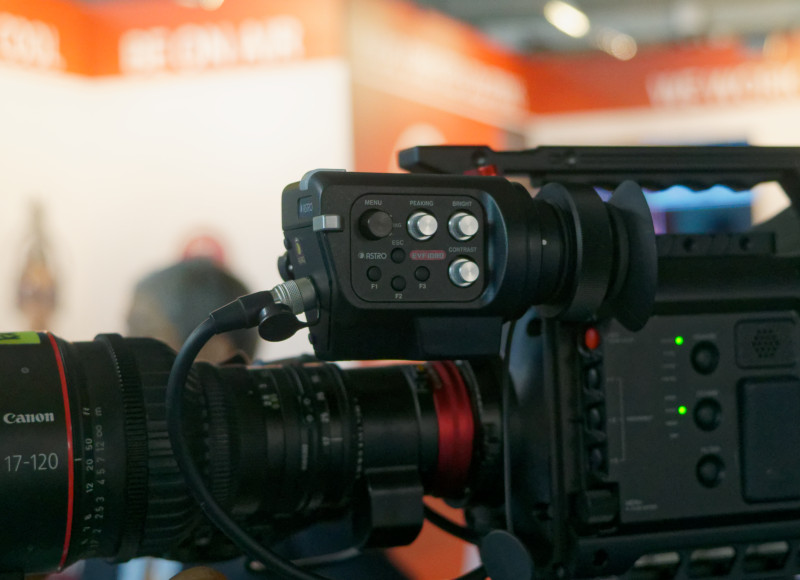 Astro showed this viewfinder on a Sharp camera with a Canon lens. Image:Meko
Astro showed this viewfinder on a Sharp camera with a Canon lens. Image:Meko
Chris reported in some detail on Bitmovin‘s technology and we met at the show to catch up. (Bitmovin Using AI for New Encoding Approach) The company has produced an interesting report on the development of codecs and streaming technologies. In particular, we were interested to see that there is a significant shift from HEVC and VP9 towards AV1. In terms of platforms, HTML5 in the browser is the technology of choice for most. The report identifies that broadcast delay and getting playback to run on all devices are the biggest problems for survey participants. The full report can be downloaded here. (registration required) The company told us that it expects chip vendors to talk about AV1 at CES in 2019, with new sets with support by around 2020.
 Bitmovin surveyed to find the biggest OTT video problems.
Bitmovin surveyed to find the biggest OTT video problems.
Calman was in a very positive mood after the recent announcement that Sony was joining Panasonic, Samsung and LG as an integrator of Calman/Portrait Displays technology into their TVs. Martin Fishman of Calman told us that channels in particular are seeing the value in performing calibration and set makers want to enable access. Often, a TV that is factory set-up error of <3 DeltaE can be reduced to an error of <1. We’re planning a feature on the way retailers are reacting to this opportunity in the future.
Canon had less space devoted to monitors this year than in previous years. It’s only news was of the two monitors that were announced at NAB (Canon Debuts Two New Monitors). The company told us that the optional boost in brightness for the V1711 from the standard 300 cd/m² to 600 cd/m² costs €1,000. The company highlighted a feature that allows single pixel mapping to see colour values. Canon also told us that its monitors have been used in facilities that are certified for Netflix (Netflix doesn’t certify displays, but does certifies facilities.
 We asked Canon about HDR and the company showed us this list. Preset Log 1 might look very much like Sony S-Log. Image:Meko
We asked Canon about HDR and the company showed us this list. Preset Log 1 might look very much like Sony S-Log. Image:Meko
Christie had a meeting room and was showing a new UltraHD touch display, using infrared touch technology. The unit is shipping now. After the event, we found out that the unit is rated for 16/7 performance had has an OPS slot and support for Crestron Connected.
Coleder, which we have been reporting on since ISE in 2016, was showing its small pitch LEDs (1.2mm and 0.9mm) and its ability to support HDR10. The LED architecture is SMD type (1010) and the company said that its LED modules can be adjusted by 3º to 6º to give curved effects. The modules fit together magnetically and normally, the back of the cabinets are cable-free, however, the internal connections only support 8 bit operation, so if the additional bits for HDR10 are needed, the cables shown in the photo are needed. The company also emphasised to us that it has rental versions of its displays.
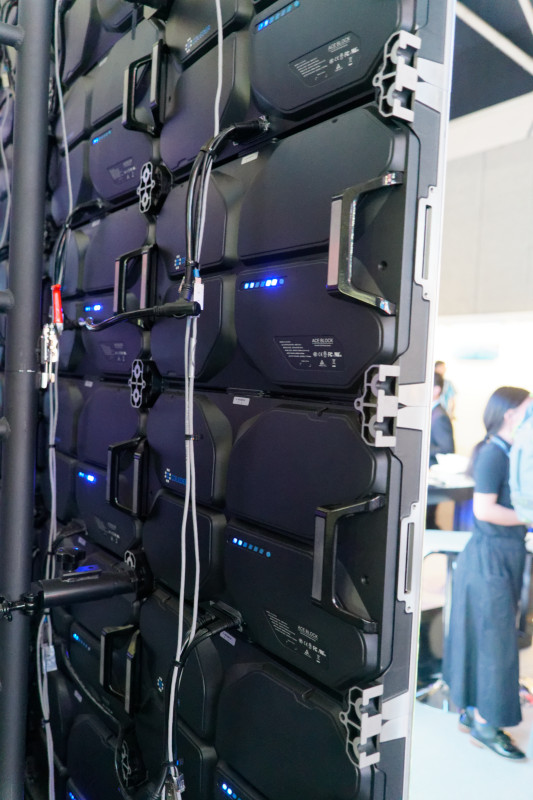 The cables are needed by Coleder for 10 bit HDR display. Image:Meko
The cables are needed by Coleder for 10 bit HDR display. Image:Meko
DesignLED is a large LED display supply company (not to be confused with the DesignLED Scottish company) that specialises in broadcast studios and applications and tends to focus its exhibition activities on IBC and NAB. The company has a number of prestigious design wins including ESPN in the US. The company makes displays down to 1.25mm pitch and can make concave or convex configurations which can be front serviced. Up to now the company has tended to work with Nova Star controllers (and occasionally, if requested, Brompton) but told us that it is increasingly moving to Colorlight as standard.
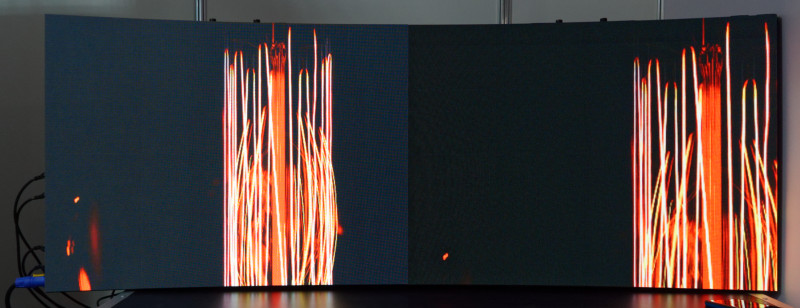 DesignLED was highlighting the improved contrast on its most recent displays. Image:Meko
DesignLED was highlighting the improved contrast on its most recent displays. Image:Meko
DVB was highlighting DCB Single Illumination System (SIS) which is a way to allow DVB-T or DVB-T2 to be sent over a DVB-S2 satellite. The stream can also be understood by standard satellite receivers. The technology will allow the distribution of FTA satellite signals and signals for terrestrial head-ends in a single stream, saving costs.
The EBU had its normal booth and most of it was devoted to audio and radio. However, there was also a presentation of the Berlin Athletics Championship, which was captured and test broadcast in UltraHD, with 100P frame rate and HDR using 10 bit HLG (shown also by Sony – and very impressively Sony Moves from OLED for Monitoring). On its booth, the organiser of the trial told us that the content was transmitted at 28Mbps. She also told us that there were just ‘too many cables’ when handling SDI!
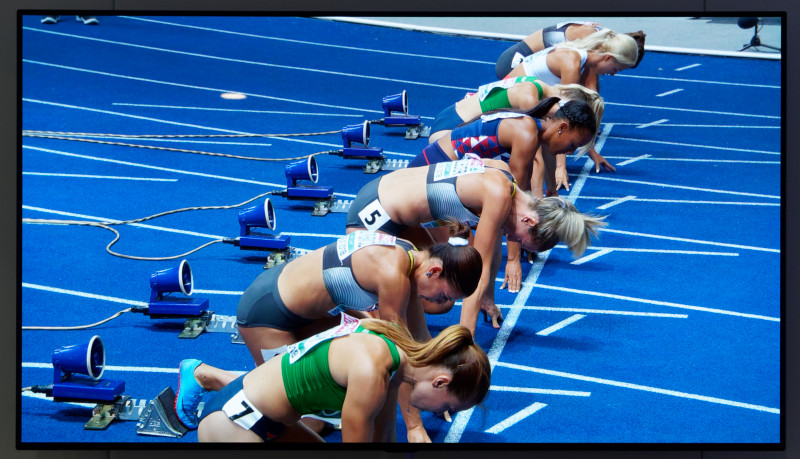 The EBU showed its impressive content from the Berlin Athletics Championship. Image:Meko
The EBU showed its impressive content from the Berlin Athletics Championship. Image:Meko
Eizo had a bigger and better booth this year and was in Hall 7 which seemed a better place for content creators. Staff were from the local company in the Netherlands and told us that the market locally was not as strong for content creation as Germany or the UK. The company was highlighting the new CG279X which is a 27″ QuadHD IPS monitor with 99% of Adobe RGB and 98% of P3 (Eizo Supports HDR Content with New Monitor). The monitor has USB Type-C connectivity, but without power delivery. The market is professional and enthusiastic amateur photographers and the monitor is expected to cost around €2000 (including tax) and should be available in December.
The company also had the CG319X that we saw at NAB and Siggraph. We asked if Eizo can support the feature that Sony has, of programmable LUTs per window in PiP operation, but this is not yet a feature of the colour-critical monitors, although staff pointed out that the company’s medical monitors have this kind of feature to ensure correct dicom grey scaling.
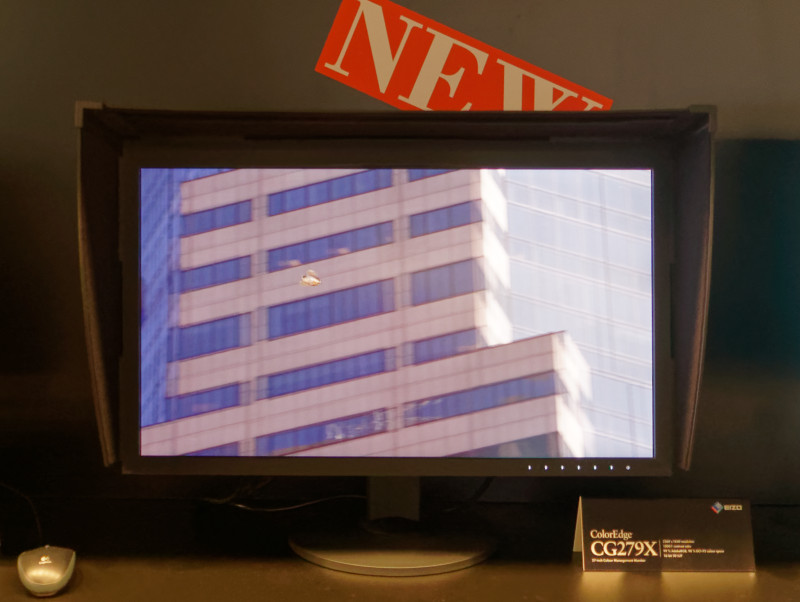 The CG279X will arrive in December. Image:Meko
The CG279X will arrive in December. Image:Meko
Software supplier, Espial, got behind Android TV and announced a full managed TV-as-a-Service (TVaaS) solution for Android TV, including support for Android TV Operator Tier set-top boxes and Android TV retail devices.
Eyevis, Leyard and Planar were sharing a booth for the first time since the acquisition by Leyard of the German company. There were no new products, but the companies were highlighting the low colour temperature displays that Eyevis has been promoting in recent years.
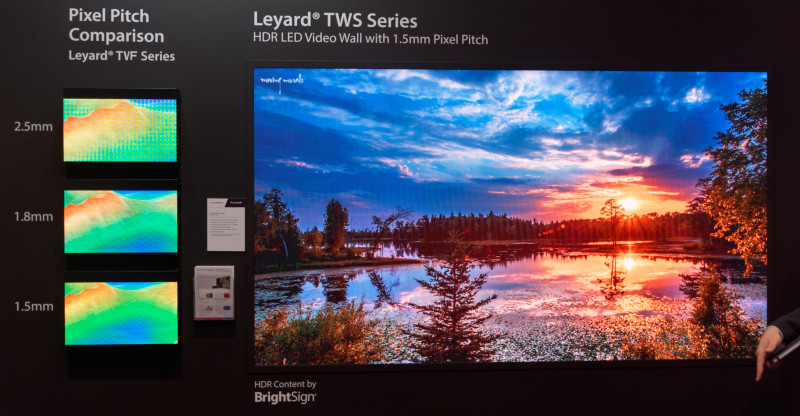 Eyevis, Leyard and Planar shared a booth for the first time. Image:Meko
Eyevis, Leyard and Planar shared a booth for the first time. Image:Meko
Broadcast monitor specialist, Flanders Scientific (FSI) had its 55″ and 65″ UltraHD OLED monitors and said that they are certified as grade 1 monitors for SDR content. Features include 4 12G SDI inputs. Also at the show were the two Panasonic-based XM310 (3,000 cd/m²) and XM311 (1,000 cd/m²) LCD monitors that it is now shipping at around $45,000 and $55,000 respectively. The choice between the two seems to be a matter of personal taste, we heard. Some want the higher brightness version so that they can see if there is something going on above the 1,000 cd/m² level, they are worried that if the monitor is limited to the target peak, they may not see any effects that are too bright. As we heard at the event at the big screen, with Pixar, that company’s artists want ‘more of everything’ and that includes brightness. FSI told us that Dolby is keen on the monitors and is helping to evangelise their use as Dolby no longer makes any high brightness monitors.
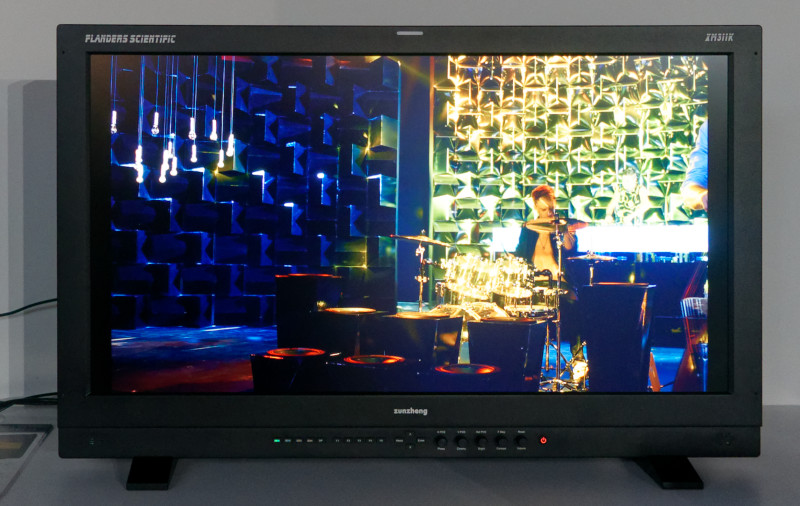 The FSI XM311K has 1,000 nits of peak brightness. Image:Meko
The FSI XM311K has 1,000 nits of peak brightness. Image:Meko
Google was promoting its Android TV solutions. As we mention in our Vewd report (below), the company confirmed that it has issues in supporting FreeView Play in the UK. At IFA and at IBC, there was definitely a buzz around Android that feels quite different from previous waves of adoption. Key to the feeling that Android TV is now a serious platform is that the company has developed an ‘Operator tier’ which allows the customisation of the front end launcher to fit the desires of operators and allowing operators to develop custom solutions. At the show, it had a cable box from Com Hem and a Satellite TV box made by Kaon Media (who actually talked to us!) for KT Telecom. It uses Alticast middleware and supports PayTV features. The SoC is a Broadcom BCM7268. However, Android TV doesn’t yet support voice search in Korean, we heard.
We also talked about the AV1 codec which was being shown running on a 2017 Chromebook in 1080P. AV1 is reckoned to be up to 30% faster than HEVC and is definitely gathering momentum, helped by the ip issues with the MPEG solution.
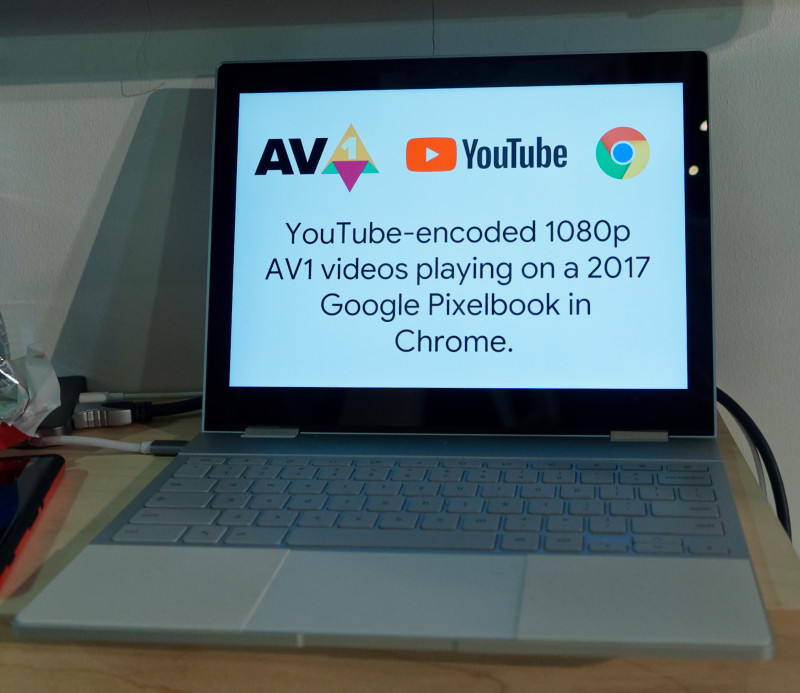 AV1 is new for a codec, but is gathering momentum. Image:Meko
AV1 is new for a codec, but is gathering momentum. Image:Meko
(one of the interesting stories we picked up talking to staff on the Google booth is that, apparently, the Peruvian government has recently enacted a law to preclude Pay TV operators from charging a rent for STBs. That kind of development makes TVs with integrated DRMs a very interesting proposition!)
Last year at IBC, HiSilicon simply wouldn’t talk to us as it didn’t want to talk to the press at all. However, this year, it was happy to show us its 8K SOC, the Hi3751V811 which is based on an Arm Cortex quad core (dual A73 and dual A53) CPU with a Mali G51 GPU. The chip supports HDR10, HLG and Dolby Vision. The decoder can process 8K at 30Hz or 4K at 120Hz and there is an HDMI 2.0 output. Features include support for CI+ and there are integrated demodulators for DTMB, DVB-C, ATSC, ISDB-T, DVB-T/T2 and DVB-S2/S2-X. The company is working with NTT and the chip was being demonstrated on an LCD TV supplied by Changhong.
The company said that it has done a deal with Access, the browser and middleware supplier, DTVKit (software for DTV receivers) and EKT(STB maker) to provide a new standardised platform that can support UltraHD.
HiSilicon was also highlighting a feature for HDMI 2.1 that the firm is proposing to enable seamless switching between SDR and different flavours of HDR. Without this, the image quality can vary a lot and that can be distracting for viewers.
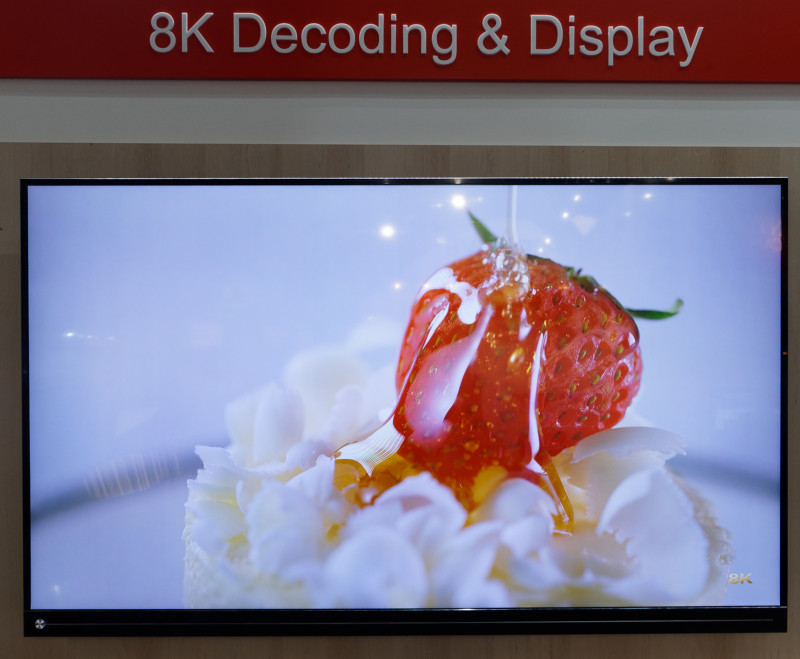 HiSilicon demonstrated its 8K SoC on a Changhong TV. Image:Meko
HiSilicon demonstrated its 8K SoC on a Changhong TV. Image:Meko
Intel was showing how its processors can be used for encoding video. Partners included Spin Digital of Germany. Intel also had a demo of tile-based encoding for VR based on technology developed by Tiled Media. Intel is working on an open source solution for the technology, as the company’s policy is to open source all its software developments. The demo was being run at 8K which may be important for VR applications. However, the bandwidth of supplying full quality for the whole image is too high, so the solution is intended to support using gaze recognition to identify the area of interest and supplying that area with high quality, with the rest being in lower quality.
 Intel is working with Tiled Media on VR streaming. Image:Meko
Intel is working with Tiled Media on VR streaming. Image:Meko
IntoPix was showing its implementation of JPEG XS which the company has already implemented on CPUs, GPUs and FPGAs. For more on the codec, which is based on IntoPix Tico with modifications, see our article on the Fraunhofer at this show. (Fraunhofer Highlights Codecs, LightFields and Packages)
iWedia, a supplier of middleware, has added to the momentum behind Android TV by announcing the release of Stage, an Operator Tier Android TV Launcher which will be available for OTT or Hybrid STBs. The company said that Stage has already been chosen by several operators which are preparing the launch of their services for the end of the year or the beginning of next year.
Kaon of Korea, which makes STBs, has been winning our ‘most unfriendly to the press award’ for the last couple of years and this year was no exception. The company didn’t want to talk to us, “Just to customers”, so we can just report that it was promoting its Android STBs and network gateways to operators.
Konvision of China is not a company that we have reported on, so far, but we had heard that companies, including Kroma Telecom, had lost business to the firm, so we tracked them down. The company was founded in 2009 in Shenzen and now has forty staff. It started with broadcast monitors and will gradually evolve into other products and categories. The company claims to have been the first Chinese company to develop 4K HDR monitors. The company tends to sell in China, South East Asia and Europe, with success in Germany, Poland, Turkey and Sweden.
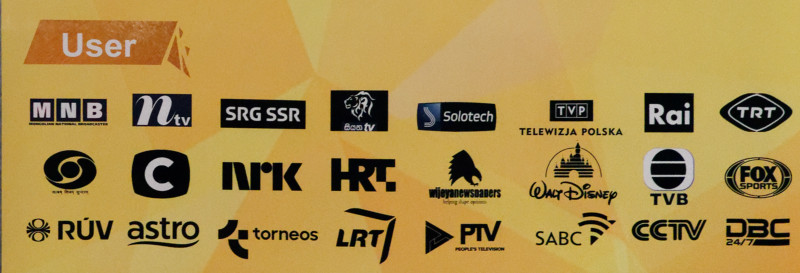 Konvision showed this customer list at IBC. Image:Meko
Konvision showed this customer list at IBC. Image:Meko
Konvision makes monitors from 2″ (really!) to 55″ and the firm said that its concept of 2″ rack-mounted monitors has been copied by a number of brands including Marshall.
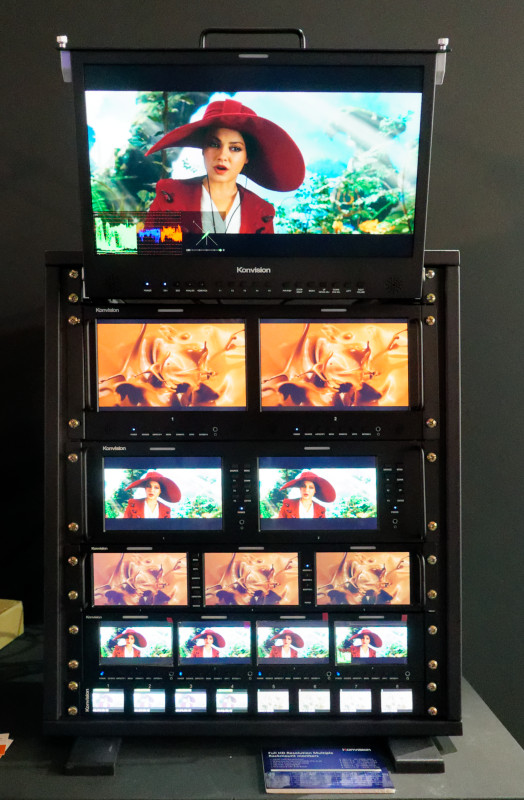 The concept of the 2″ monitor (at the bottom) has been widely copied. Image:Meko
The concept of the 2″ monitor (at the bottom) has been widely copied. Image:Meko
The best sellers for the company are the 21.5″ and 24″ displays. It has a 31″ 4K DCI monitor while other monitors in that class support UltraHD resolution. It has a Panasonic LCD-based monitor for colour grading and film production with full coverage of the DCI P3 colour gamut. The company works with Calman and Lightspace for calibration. Special features include an option of displaying the colour of individual pixels on the display.
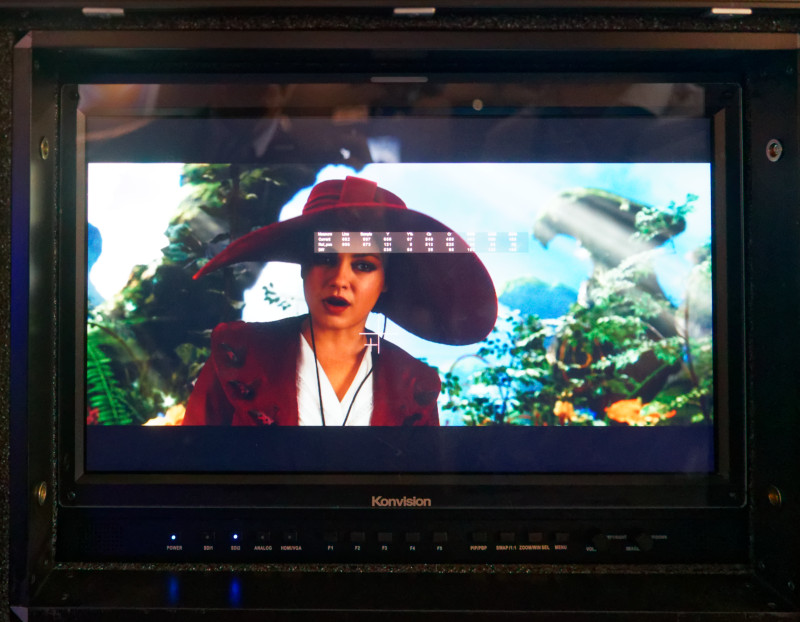 Konvision’s monitors can show the value of individual pixels. Image:Meko
Konvision’s monitors can show the value of individual pixels. Image:Meko
The group making Kroma Telecom monitors are now part of AEQ, a wider group that also makes radio and audio equipment, but the Kroma brand is maintained and production continues in Spain. The 9000 series is new and is available in 24″, 32″ and 55″ Resolution is DCI 4K on the 31″ and UltraHD on the others, with integrated audio monitoring, and two independant inputs up to 12G SDI and support for HDR and 3D LUTs. Features include WFM and Vectorscope along with many others dedicated to broadcast. The monitors were shown at NAB and are now shipping.
An interesting comment from Kroma was that it is finding it difficult to find chips with 12 bit processing. According to the firm, a major vendor paid the engineering charges to develop this in the past, but now chips are getting harder to find and nobody is adding it to new chips. The company, which promotes its good value for money, is also seeing much tougher competition recently from chinese vendors and had lost a number of projects to KonVision of Shenzen. (see above)
 Kroma is seeing tougher competition from China. Image:Meko
Kroma is seeing tougher competition from China. Image:Meko
Liantronic had nothing new in its LEDs since Infocomm although it told us this time that its smallest pitch is 0.9mm, rather than the 0.8mm it was talking about in Las Vegas. At IBC, the company had a 7680 x 1080 display and was highlighting its VA series.
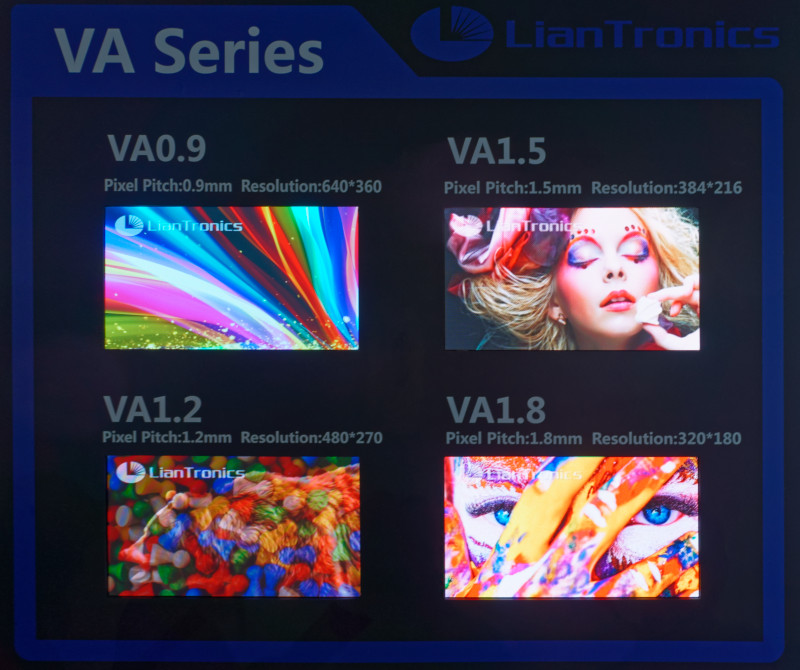 Liantronics highlighted its VA series. Image:Meko
Liantronics highlighted its VA series. Image:Meko
Liberty Global released its new entertainment platform, ‘Horizon 4’, which will roll out in Switzerland, The Netherlands and Belgium, with other European markets to follow. The platform has already been rolled out as the ‘V6 box’ in the UK where there are two million users who can use it in combination with the TiVo platform.
The new Horizon 4 user interface includes enhanced features such as:
- Access to linear TV, Replay and Video on Demand;
- Apps such as Netflix and YouTube – all in up to 4K Ultra HD picture quality;
- Cloud storage of recordings – eliminating the need for a built-in hard drive;
- At a later stage a wide, constantly-updated selection of web videos and online TV channels will be available;
- All content is accessible via the single easy-to-use, newly-designed user interface;
- A new remote with voice capabilities to control the box or search for things to watch just by speaking into the remote, offering an easier and more intuitive way of getting access to features and content.
Also part of the new platform is a further enhanced version of the ‘GO’ mobile app which allows customers:
- To watch content on-the-go – be it linear TV, replay or on-demand, whenever and wherever they want;
- ‘Download to go’ functionality for a significant amount of content when going abroad or for viewing in an area without wifi or mobile coverage;
- Viewers can continue watching the same program where they left off on a different device – whether that be a mobile, tablet, laptop or TV;
- The mobile app can also be used to control the set-top box or use ‘push to TV’ functionality to watch content on the big screen after searching for it with the app.
Matrox highlighted to us that has added a dual channel graphics to IP encoder, the 6120 Maevex to join the single and quad options that it had before. The company also told us that it has done a deal for the 6020 box which will be co-branded with Panopto, said to be one of the leaders in lecture capture technology (and the largest outside China). The box will integrate with the cloud platform, but can also save streams with audio to local memory for later upload (in case of internet outages). The box can also be used for local device control.
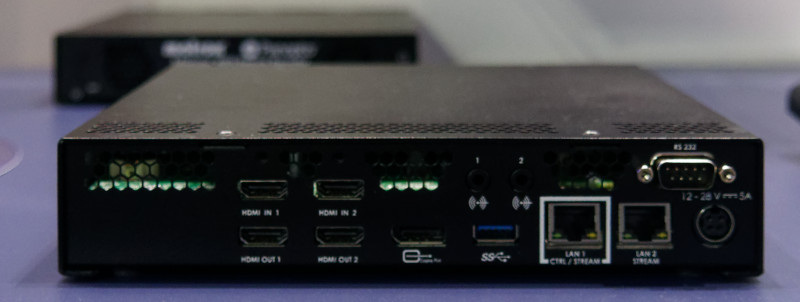 The new Matrox box encodes dual streams. Image:Meko
The new Matrox box encodes dual streams. Image:Meko
MStar told us in its suite that most of its emphasis at IBC was on the development of Android TV as it sees this as a big growth area for the future of STBs and also SmartTV.
Nagra was talking about the next development of its TV Key technology which it introduced with Samsung to enable USB keys that can authorise content. The company told us at IBC that it is extending this and that all of Samsung’s Smart TVs in 2019 will have the CAS technology integrated. For more see our Display Daily (An Inflection Point in Pay TV Production to Delivery). Nagra has now made Android TV Operator Tier a standard feature of its OpenTV Signature Edition. Nagra has previously 14 Android roll outs.
NKK was showing its range of switches which includes a new range that has higher resolution panels. The switches can be loaded with dynamic data including video. The latest switches have 96 x 64 pixels with 16 bit colour and there are alternate versions at 64 x 48 pixels. The new switches have no dark borders around the display, unlike the previous versions which had borders. The firm also has LCD-based switches.
 The black stripes were an artefact from our choice of shutter speed and were not visible in practice. Image:Meko
The black stripes were an artefact from our choice of shutter speed and were not visible in practice. Image:Meko
Nokia and France Télévisions, the French national public TV broadcaster was planning to show an 8K signal going over 5G at the event, although we didn’t spot it.
Philips Professional Displays, which is run by MMD and licences the Philips brand for monitors, LFDs and hospitality TVs, announced that it has a CAM from VSecure that can be used to secure content to TVs that do not have the feature integrated (which some recent ones and some STBs do have). The VSecure system is claimed to be the de facto standard for encryption technology in the European professional TV market.
PNY was at the show and highlighting its Nvidia Volta-based graphics cards but, as we saw at IFA, there were no Nvidia Turing-based cards at the show. Perhaps even more surprising, given the push towards content creators at Siggraph, Nvidia themselves did not have a presence at the show this year, despite having attended in previous years. As at IFA, we didn’t see RTX anywhere (and we heard a rumour at the show that Nvidia may only have 15 or so Turing chips, globally, but, of course, we couldn’t confirm that!)
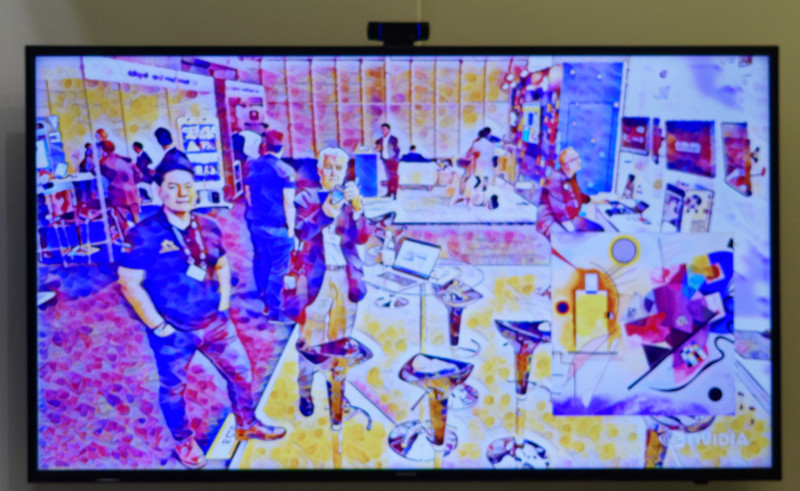 PNY’s professional cards are based on the Nvidia Quadro and can perform real time processing. Image:Meko
PNY’s professional cards are based on the Nvidia Quadro and can perform real time processing. Image:Meko
ROE, which is, effectively, the rental division of Unilumin, told us that it had got a very good response to the new rental frame architecture that it launched at Infocomm. IBC represented the European launch of the technology, which will start shipping from October.
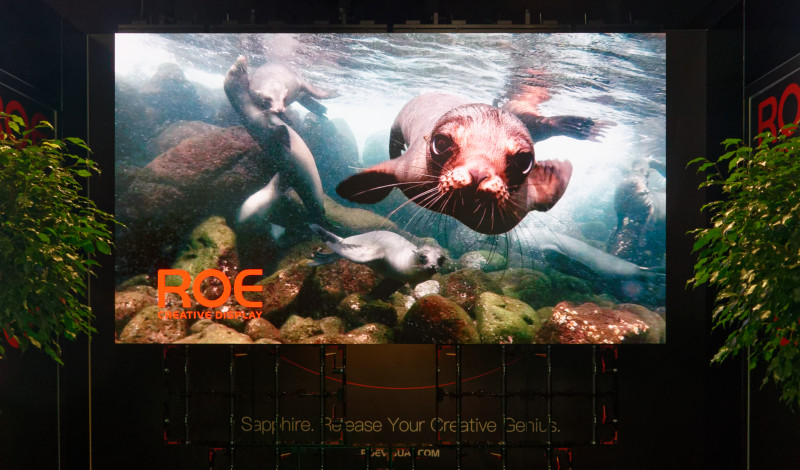 ROE’s new mechanical system has had a good response. Image:Meko
ROE’s new mechanical system has had a good response. Image:Meko
We have been fans of the Roku TV operating system since we first saw it. However, it is still not rolling out in TVs in Europe, although it is available with streaming sticks. That has become a frustration for companies such as TCL, which was an early adopter of the technology when it came out in the US, and which has done very well with it there. Roku told us that the problem is simply one of scaling up with some control. The company started shipping in 2014 and by 2015 had 8% of US Smart TVs and that number has grown to around 25% this year. It has expanded to Canada and Mexico and is now supporting 11 different brands, the latest being the JVC licensed brand. From 230 staff at the end of 2014, the company now has around 1,000. It has done will with streaming dongles and is in the Sky Now TV streaming box in the UK. It also has a streaming player with Telstra, which is supporting ‘free broadband’ with the player. Overall, the company now has 22 active accounts. So, it is progressing as rapidly as it can, but doesn’t want to go too fast.
The company is developing its own voice assistant, but has not got a date set on a launch, so is working to support Google Assistant. The feature is likely to roll out to streaming players in November and to Roku TVs early in 2019. The update (to OS 9) will also add Spotify support and automatic volume levelling.
The Roku platform will also be used for the launch of the first UltraHD HDR OTT linear channel, which is being published by Nasa. The channel will be available globally. Nasa said that it would be re-scanning some of its contents, but other content was captured on 4K and 8K cameras.
Analyst Comment
The comments from Roku make a lot of sense – there’s an old saying that “it’s better to do a few things well, than a lot of things badly”, but the TV OS landscape is changing rapidly and Android, in particular, now it has its service tier, could cause a blocking of some markets for Roku. On the other hand, we have heard that Google is only really interested in the top players. I suspect that this is ‘at the moment’, Google has a pretty voracious appetite for dominating markets, it seems to me! (BR)
Sarnoff Research is a famous name in TV and the company was at IBC to show off its test patterns for broadcast chains. The company has a generator that can produce a wide range of sophisticated patterns which not only indicate problems in quality (e.g. handling HDR content), but can also help with problems such as wrong cabling in SDI (SDI can send interleaved pixels on separate cables, and if they are connected wrongly, it can cause a lot image problems, but is hard to diagnose correctly and quickly). There are also patterns that help content creators see how content will look when shown with different EOTFs (such as HLG or PQ) and colour spaces.
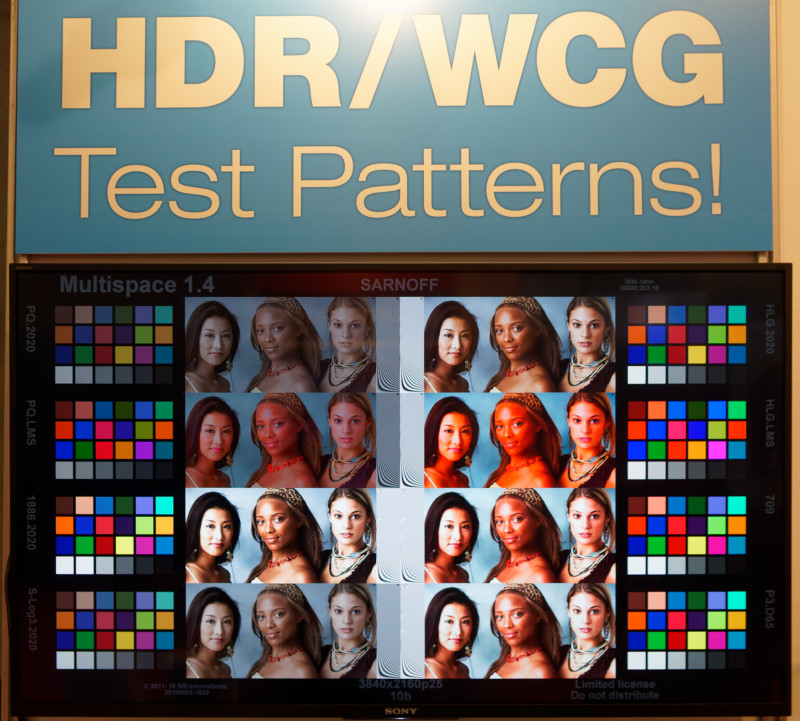 Sarnoff has a range of test patterns that can be useful for understanding different colour spaces and EOTFs. Image:Meko
Sarnoff has a range of test patterns that can be useful for understanding different colour spaces and EOTFs. Image:Meko
Skyworth had a big booth at the show and was highlighting Android TV support. There was an UltraHD STB with Irdeto support (via a HiSilicon Hi3796mv299) and ‘Netflix ready’ (Netflix support is not a standard feature of Android TV, which is often a surprise to potential adopters). Skyworth has a very small Wi-Fi ‘dongle’ which can run Android TV in just 1GByte of RAM.
 Skyworth had this small Android TV dongle for Wi-fi. Image:Meko
Skyworth had this small Android TV dongle for Wi-fi. Image:Meko
SmallHD was demonstrating its field monitors, which are based on LCD or OLED displays. The company is working closely with Teradek which supplies wireless connectivity to transmit or receive video which can be very convenient.
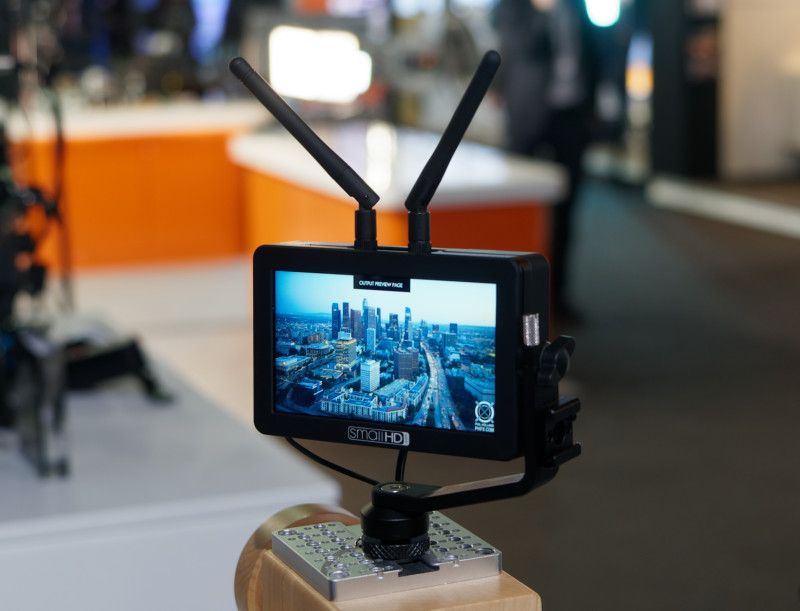 SmallHD is working with Teradek for wireless technology. Image:Meko
SmallHD is working with Teradek for wireless technology. Image:Meko
SonoVTS is a supplier of broadcast monitors and although the company had no new products on the booth, it told us, there was a very interesting ‘back room’ demonstration of the performance of its monitors when used in a typical outside broadcast van to show Rec 2020 and HDR content. Using a 1,000 cd/m² peak brightness or even more, is very bad news in OB vans which are typically quite dark and bright highlights can cause the eyes to lose adaptation. SonoVTS has a special 250 cd/m² peak mode that allows a good understanding of how the HDR will look, but also allows comparison with SDR content in Rec. 709 and with just 100 cd/m² of brightness. The monitors have specially designed backlights to enable this HDR preview mode and units are available from 17″ to 65″. SonoVTS was the only vendor that we spoke to at the show that has already integrated SMPTE ST 2110 inputs directly into its broadcast monitors. (We actually found a few that didn’t even seem to know what ST 2110 is!)
 SonoVTS has ST 2110 and HDR Preview Monitors from 17″ to 65″. Image:Meko
SonoVTS has ST 2110 and HDR Preview Monitors from 17″ to 65″. Image:Meko
We have reported several times on Spectral Edge of the UK which has image processing technology to deal with colour blindness, to reduce blue light without excessively changing skin tones or reducing sharpness (which it calls Nighteq) and making SDR content look more like HDR (Vividteq). Spectral Edge has worked with NTT data to provide content for Sky Italia to improve the look of soccer coverage using psycho-visual pre-encoding. NTT Data has a filter card to perform this process. One of the features of the Vividteq processing is that the pre-processing can reduce the required bitrate for a given perceived quality. Processing can be performed on a GPU and CPU.
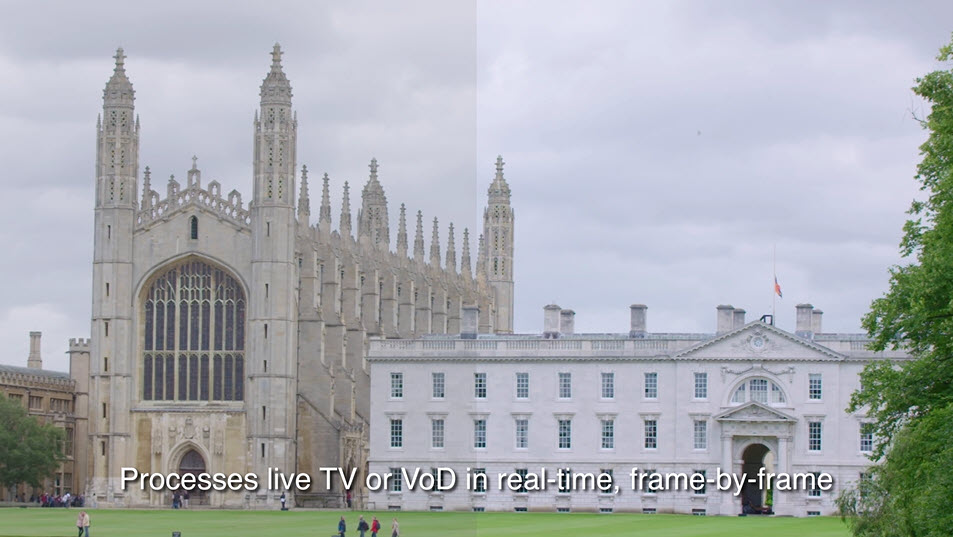 The Spectral Edge Vividteq technology enhances contrast.
The Spectral Edge Vividteq technology enhances contrast.
TVLogic started by showing us a 7″ field monitor, the F7H which is a very high brightness (3,600 cd/m²) unit for HDR monitoring uses an edge-lit LCD and takes around 30W of power. Inputs include SDI and HDMI and the monitor can convert from SDI to HDMI. There are lots of broadcast-related features including waveform & vectorscope, audio level meters, focus assist, range error, time code display, various aspect ratios and markers and 3D LUT import. There is HDR support including PQ, HLG and S-Log3 and staff told us that custom settings are possible.
The company also has a new 5.5″ OLED field monitor, the VFM-055A with FullHD resolution, SDI and HDMI inputs and 350 cd/m² of output, with contrast of 17,000:1.
On the booth was the ex-SHV+ which is an SDI-HDMI converter that includes an integrated display to show the image. It is made by Lumantek.
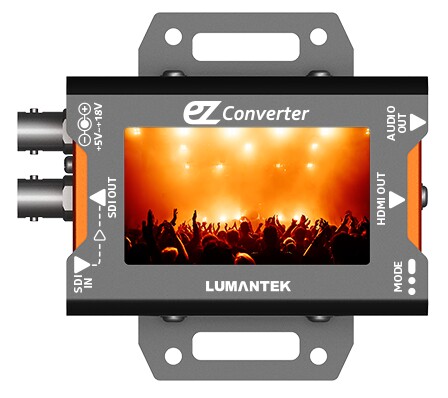 This SDI to HDMI converter includes a display is from Lumatek
This SDI to HDMI converter includes a display is from Lumatek
The LVM-241S was shown as a prototype last year, but the 24″ 16:10 monitor is now in production. It has 1,500:1 contrast with 400 cd/m² of output. Other products were as shown at NAB (TVLogic Demos HDR Grading Monitor).
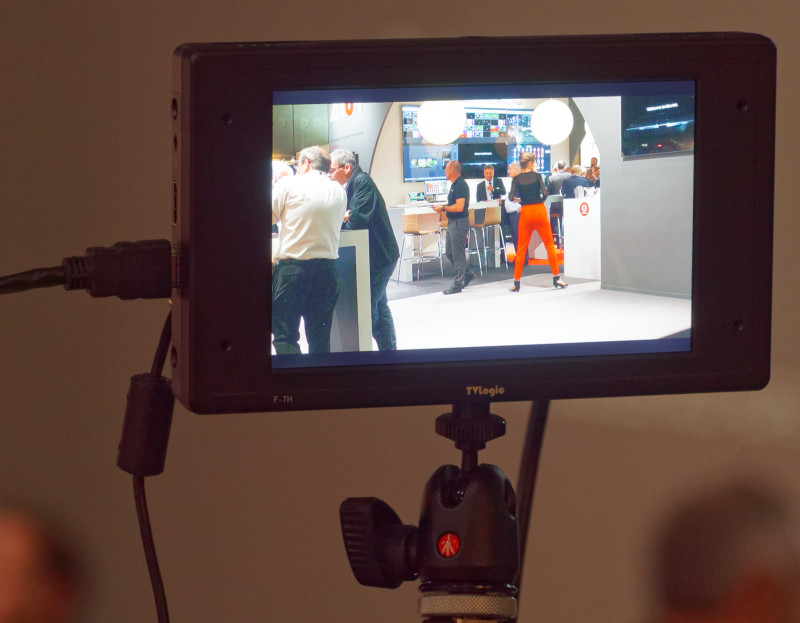 TVLogic has a field monitor with 3,600 cd/m² of output. Image:Meko
TVLogic has a field monitor with 3,600 cd/m² of output. Image:Meko
LED display maker, Unilimin, did not have any new products since we saw the firm at Infocomm. We had a discussion about the pros and cons of CoB technology and the firm told us that a factor in its reluctance to go that way is the level of investment needed.
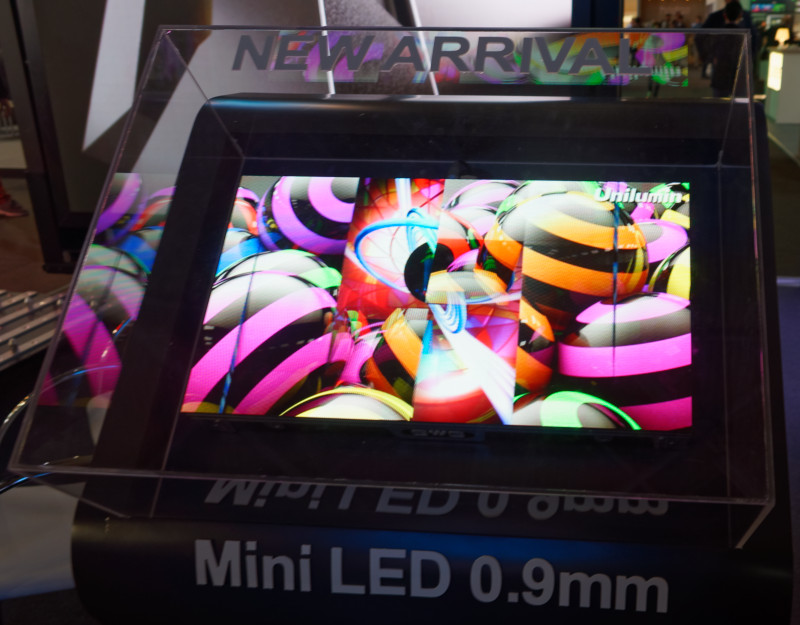 Unilumin described its 0.9mm LED as MiniLED, but it’s not by our definition. Image:Meko
Unilumin described its 0.9mm LED as MiniLED, but it’s not by our definition. Image:Meko
Vestel was mainly promoting its STBs. However, we also found out that the company has a new TV that includes Irdeto embedded CAS technology. That technology means that PayTV operators can supply content to individually authorised sets and Vestel is promoting the technology in its home market of Turkey, initially. See our Display Daily for more discussion of the implications of this. (An Inflection Point in Pay TV Production to Delivery).
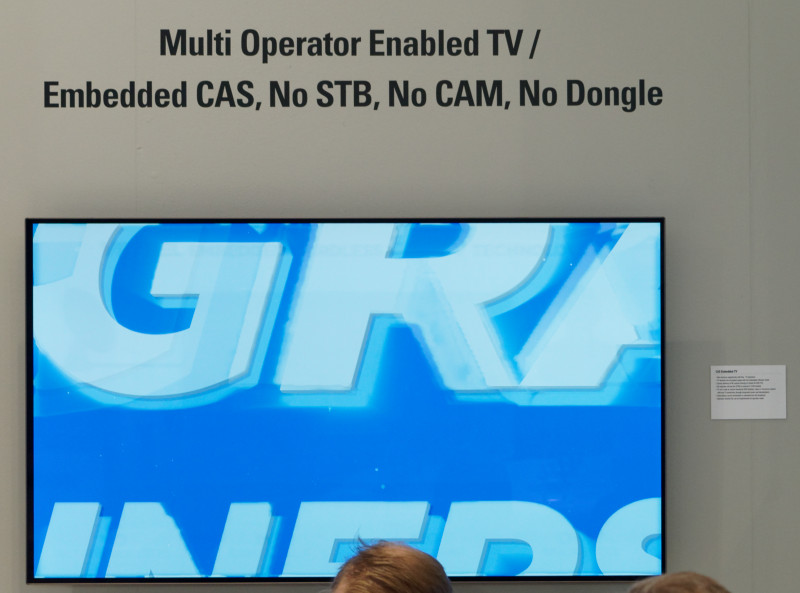 Vestel showed its Smart TV with CAS integrated. Image:Meko
Vestel showed its Smart TV with CAS integrated. Image:Meko
The company also said at IBC that it is implementing the ExpressPlay XCA which is Intertrust’s video conditional access system (CAS) based on the open standard Marlin DRM (Digital Rights Management) technology. ExpressPlay will be implemented in SmartTVs and STBs in 2019. Intertrust co-founded the Marlin DRM open standard with Sony, Samsung, Philips, and Panasonic in 2005. Marlin DRM is used globally in over a billion devices and apps and is the only open standard for content management and protection.
Codec developer, V-Nova was in good form at the show. Although the video codec landscape is quite complicated, with MPEG-2, H.264, HEVC all shipping and in high volume use, VVC being developed, VP9 in browsers and AV1 starting to roll out, a side effect of the proliferation is that it becomes immediately clear that there is not a ‘one size fits all’ situation in codecs and that there are different solutions that may be appropriate in different situations and at different times.
One of the developments that we heard about is that the company has lots of trials and deployments going on and it has developed its software to allow encoding in the cloud. No special cloud technology is needed and the transcoder or encoder can run on AWS or other public cloud platforms. As a result of the development, the company has realised that there are significant savings to be made in the encoding process as the Perseus codec needs less power to compress than other solutions. The cost of encoding is a real one for customers and is another factor, beyond bitrate reduction, that is making the technology attractive. Once again, the company has very good demonstrations of the high quality with low bit rates – a killer feature for streaming to mobile handsets – and it says that it can stream UltraHD at 60P using just 8 Mbps.

